Vol. 5 No. 28 TROPIC LIGHTNING NEWS July 27, 1970
Index
Radar and Gunships
Alert Dragons Zap Sappers
By SP4 RICH ERICKSON
DAU TIENG - An alert group of “Golden Dragons,” 2nd Battalion, 14th Infantry,
by pinpointing movement outside the perimeter and utilizing quick gunship
support, recently turned back a nighttime sapper attack.
“Suddenly there were three new blips on the screen,” said Echo Company radar
operator, Specialist 4 Nathaniel Dixon, Pensacola, Fla.
Word was relayed to the tower where observers using starlite scopes spotted
11 sappers loaded with equipment.
Air Support
The entire perimeter was alerted and within minutes Cobra gunships from Delta
Company, 229th Aviation Battalion, were firing on the suspected enemy positions.
A search by Golden Dragons in the morning turned up three enemy dead and two
wounded, as well as an AK-47 assault rifle, 18 sachel charges, 46 Chi-com
grenades, wire cutters and entrenching tools.
Aftermath
Later in the morning, Alfa Company engaged a group of NVA several kilometers
east of Dau Tieng and after a brief fire fight captured two additional wounded NVA.
“They both had charcoal blackened faces,” recalls an Alfa Company rifleman,
“and they seemed to be exhausted from running.”
‘Chieu Hoi’ Shout Yields Worthy Ally
By SP4 GREG DUNCAN
CU CHI - It’s not everyday that a routine sweep of an area results in a rallier, a cache and a potential Kit Carson Scout.
Recently, a reconnaissance patrol from Bravo Company, 2nd Battalion, 27th
Infantry, “Wolfhounds,” turned up a tired, disgruntled, but most cooperative
enemy nine miles north of here.
Chieu Hoi
“During a daytime sweep, our scout dog alerted us to some nearby brush,”
explained Sergeant Gilbert Stogsdill, a Bravo platoon sergeant from Iowa Park, Tex.
“As we were checking it out, we heard this guy spout, ‘Chieu Hoi.”
“He was standing there with his arms raised high,” Stogsdill continued. “He
looked pretty hungry so we gave him something to eat, while our Kit Carson Scout
questioned him. The Hounds’ friendly manner put the rallier at his ease and he
told his story:
Platoon Leader
The man was a leader of a 30-man NVA platoon that was new to this area. They
had attacked an ARVN compound two months previously, and lost most of their
men. In the ensuing escape from the ARVN the men had split up, and he was left
in charge of three other men.
“We couldn’t take two steps without artillery coming in on us,” explained the
rallier. “For the last few days, gunships and artillery had been constantly
harassing us.”
Worried
The gunships worried them so much in fact, that the three men the rallier had
been in charge of had seemingly gone crazy and were apparently wandering around
the countryside.
“Being left alone with no food and so many Americans everywhere, I decided it
best to give myself up,” he explained.
Broadcast
The treatment the rallier received from Bravo Company produced further
gains. When he was asked to go up in a chopper to broadcast a Chieu Hoi message
to his comrades, he jumped at the chance. He also led the Wolfhounds’ Charlie
Company to a cache in a booby trapped area. The cache produced 240 pounds of
TNT and 20 gallons of gasoline.
On leaving the Hounds for more processing, he went around smiling and shaking
hands and saluting his new-found friends.
“He wants to be a Kit Carson Scout, and we’d sure like to have him back,”
said Bravo Company Commander, Captain David Howery from Alen Park, Mich.
Valorous Unit
3/4 Cav Honored
CU CHI - The 3rd Squadron, 4th Cavalry was recently presented the Valorous
Unit Award for extraordinary heroism during operations in Binh Duong Province
early last year. Major General Edward Bautz, Jr., commanding general of the
division presented the award to the officers and men of the unit in ceremonies
held at the squadron area.
The general noted in particular the squadron’s determined aggressiveness and
combat proficiency as it maneuvered against well fortified enemy strongholds and
engaged in prolonged fighting in the Boi Loi Woods and surrounding enemy
controlled territory.
57 Streamers
The 3rd Squadron, 4th Cavalry, “McKenzie’s Raiders,” traces its history back
to the Indian Wars. This award is the Cav’s 57th in 115 years and its second in
Vietnam.
During recent Cambodia operations, gunships from the Cav’s Delta Troop flew
in support of the first 25th Division units south of the Dog’s Face. The entire
unit moved into the region north of the Dog’s Face when Tropic Lightning troops
crossed the border.
Stayed On
After other division units returned to Vietnam, the Cav stayed on working
with Vietnamese units until June. It was one of the last U.S. units to return
to Vietnam.
The Cav’s potential as a striking force is based in its versatility.
Aviation, armor and mechanized infantry troops all operate under the 3/4 Cav
banner.
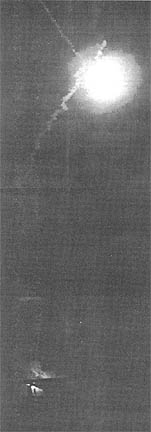 |
FLARE -- Bright in the late evening sky, a flare shot from the bunker line in Katum aids 4th Battalion (Mech), 23rd Infantry, night defense. (Photo by SGT Mike Keyster) |
| It Really Happens... CU CHI -- Miraculous luck and an unbelievably hard head were the only things that saved the life of a somewhat bewildered donut dolly recently, when upon attempting to enter and seat herself in a light observation helicopter (LOH), she inadvertently stood up in the doorway. The young lady, whose identity has not been disclosed, got a hefty slap from the rotor blade, but suffered not a scratch. Fellow Red Cross girls bestowed upon Miss Hard-Head a “Purple Donut” for injuries almost incurred. |
Page 2 TROPIC LIGHTNING NEWS July 27, 1970
Decorated
| SILVER STAR | |
| PFC Dana W. Mertz, C Trp, 3d Sqdn, 4th Cav | |
|
DISTINGUISHED FLYING CROSS |
|
|
CPT Michael J. Haggar, D Trp, 3d Sqdn, 4th Cav WO1 Michael D. Holder, D Trp, 3d Sqdn, 4th Cav WO1 Kenneth H. Rucki, D Trp, 3d Sqdn, 4th Cav WO1 Craig T. Tate, HHC, 2d Bn, 14th Inf |
SP4 Michael R. Bagley, D Trp, 3d Sqdn, 4th Cav SP4 William F. Byers, D Trp, 3d Sqdn, 4th Cav SP4 Edward R. Eden, D Trp, 3d Sqdn, 4th Cav SP4 Calvin E. Williams, D Trp, 3d Sqdn, 4th Cav |
|
BRONZE STAR |
|
|
CPT William R. Lechner, Co A, 2d Bn, 22d Inf CPT Terrence K. H. Wong, Co E, 2d Bn, 27th Inf 1LT Wilmore H. Aldridge, Co C, 2d Bn, 22d Inf 1LT Joseph R. Belew, Co C, 2d Bn, 22d Inf 1LT Michael A. deMari, Co C, 2d Bn, 22d Inf 1LT James H. Kyes Jr., Co A, 2d Bn, 14th Inf 1LT Henry W. Sandhusen, C Trp, 3d Sqdn, 4th Cav SFC Jose N. Jaramillo, Co A, 2d Bn, 14th Inf SGT Paul D. Allison, Co E, 2d Bn, 14th Inf SGT Wilfred R. Beaudoin, Co A, 2d Bn, 22d Inf SGT Richard B. Burke, Co A, 2d Bn, 22d Inf SGT William G. Kock, Co C, 2d Bn, 22d Inf SGT Michael Marcum, Co C, 3d Bn, 22d Inf SGT Craig Suitak, Co A, 2d Bn, 14th Inf SGT Jerry L. Waller, Co A, 2d Bn, 22d Inf SGT James A. Wolfe, Co A, 2d Bn, 14th Inf SGT Terry W. Zych, Co B, 2d Bn, 14th Inf SP4 Sammy D. Booker, Co C, 2d Bn, 22d Inf SP4 Deith R. Bowman, Co A, 2d Bn, 14th Inf SP4 Carl J. Caprood, Co C, 2d Bn, 27th Inf SP4 John E. Goral, Co B, 3d Bn, 22d Inf SP4 Mark V. Nash, Co C, 2d Bn, 22d Inf SP4 Larry Ramsey, HHC, 3d Bn, 14th Inf SP4 Mertis L. Snyder Jr, Co A, 2d Bn, 14th Inf SP4 Billy J. Rodgers, Co A, 4th Bn, 23d Inf SP4 Robert Roff, Co A, 4th Bn, 23d Inf SP4 John Romito, Co B, 2d Bn, 14th Inf SP4 Richard Rose, Co C, 3d Bn, 22d Inf SP4 George E. Scott, Co A, 4th Bn, 23d Inf SP4 Gary L. Sloan, Co A, 4th Bn, 23d Inf SP4 Albert E. Souza, Co A, 4th Bn, 23d Inf SP4 Johnny R. Talbott, Co A, 4th Bn, 23d Inf SP4 Donald L. Thomas, Co C, 3d Bn, 22d Inf SP4 Charles M. Tanner, Co A, 4th Bn, 23d Inf SP4 Donald L. Thomas, Co C, 3d Bn, 22d Inf SP4 Bruce G. Tindall, A Trp, 3d Sqdn, 4th Cav |
SP4 Rommy J. Tompkins, Co C, 3d Bn, 22d Inf SP4 David R. Wallace, Co A, 4th Bn, 23d Inf SP4 Mark C. Walsh, Co A, 4th Bn, 23d Inf SP4 Paul R. Warden, Co A, 4th Bn, 23d Inf SP4 Leonard Wheeler, Co A, 3d Bn, 22d Inf SP4 Herman M. Wood, D Trp, 3d Sqdn, 4th Cav SP4 Andrew J. Zwalesky, A Trp, 3d Sqdn, 4th Cav PFC Bruce W. Abshagen, Co B, 2d Bn, 14th Inf PFC Thomas L. Amiot, Co A, 4th Bn, 23d Inf PFC Gary L. Andrews, Co A, 3d Bn, 22d Inf PFC John F. Banas Jr, Co A, 4th Bn, 23d Inf PFC Earl Botten, Co B, 4th Bn, 23d Inf PFC Michael W. Brooks, Co A, 4th Bn 23d Inf PFC David L. Eide, Co B, 2d Bn, 14th Inf PFC Rovert Enoch, Co C, 3d Bn, 22d Inf PFC Jose Espinosa, Co A, 4th Bn, 23d Inf PFC Phillip J. Gessert, Co A, 4th Bn, 23d Inf PFC Larry W. Gibbs, Co A, 4th Bn, 23d Inf PFC Terrence Huettner, A Trp, 3d Sqdn, 4th Cav PFC Terry L. Johnson, Co A, 4th Bn, 23d Inf PFC Steven T. Jones, Co C, 3d Bn, 22d Inf PFC Harold M. Leroux, Co B, 4th Bn, 23d Inf PFC Henry P. Luevano, C Trp, 3d Sqdn, 4th Cav PFC John Matteson, Co A, 4th Bn, 23d Inf PFC John W. Phillips, Co C, 3d Bn, 22d Inf PFC William S. Purpera, A Trp, 3d Sqdn, 4th Cav PFC Raymond Creslica, Co C, 2d Bn, 22d Inf PFC Michael Dempsey, C Trp, 3d Sqdn, 4th Cav PFC Thomas E. Greenblatt, Co C, 2d Bn, 22d Inf PFC Larry A. Hansen, Co C, 2d Bn, 22d Inf PFC Alan D. Lett, Co C, 2d Bn, 27th Inf PFC Robert L. Pyle, Co A, 2d Bn, 14th Inf PFC Jerry A. Reeves, C Trp, 3d Sqdn, 4th Cav PFC Gilbert A. Rodriguez, Co A, 2d Bn, 14th Inf PFC Andrew O. Wilda, Co A, 2d Bn, 22d Inf PVT Vester L. Stewart, Co A, 2d Bn, 14th Inf |
Red Cross
There When You Need It
The distance between the serviceman and his family never seems as great as
it does when an emergency develops at home. It is at a time like this that the
Red Cross can come to the rescue.
Every serviceman should know how to use the Red Cross during times of crisis.
The Red Cross can assist in sending or receiving emergency information. It
is always on hand to help transmit word concerning family deaths, births, health
reports or anything else of an emergency nature. In short, they try to lessen
the distance between the GI and his home.
When an emergency does arise, and a serviceman’s family has reached him
through the Red Cross, an emergency leave may be considered necessary. The Red
Cross is there to confirm the crisis and report the facts to the commanding
officer - the only person who can actually grant emergency leaves.
Financial Assistance
Should a serviceman or his dependents require financial assistance to meet an
emergency, the Red Cross is there to help. Funds advanced by the Red Cross
field director are usually in the form of non-interest loans. Repayment can be
made by salary allotments depending upon the serviceman’s ability to pay. In
cases of extreme hardship, a grant or combination loan and grant may be
extended.
Often the soldier’s problem is just a breakdown in communication with his
family. Here the Red Cross can assist by attempting to get in touch with his
family or getting him word of what might have caused the problem.
The Red Cross field director can also assist with other personal and family
problems.
It’s Your Money
By SP4 SCOTT WATSON
Back in the Wild West days, when a big spender from the East came to a small
cow town, his lavish spending threw out of proportion the values of the humble
citizens. Money-laden U.S. troops have had much the same effect on the humble
Vietnamese.
Americans have more to spend than the average Vietnamese citizen, so they are
willing to pay more for goods and services. For instance, some GIs would pay
200 piasters for a taxi ride that generally costs the Vietnamese only 25
piasters. So, of course, the cab drivers raise their fares and look for the
“big spenders.”
This economic competition caused by U.S. servicemen has brought about
inflation and has encouraged illegal currency transactions, which in turn have
damaged our war effort, as well as the Vietnamese economy. Considering that
Free World Forces spend on the average about $60 million annually, this problem
is not one to be taken lightly.
There are many ways which a GI can help the Vietnamese economy and fatten his
own wallet as well.
Interest in generous amounts can be earned by stashing money in one of the
safe places provided by the Army. Uniformed Services Savings Deposits, Saving
Bonds, checking accounts, and Class E allotments can all safeguard a
serviceman’s cash and pay him generously in the process.
A soldier’s memories of Vietnam could include a new car or stereo, camera,
six days with his wife or fiancee in Hawaii and a solid bank account, simply
because he didn’t throw his money away on silk jackets that fall apart at the
seams and coke and beer at 100 piasters a can.
|
CHANGE OF COMMAND Lieutenant Colonel Nathan Vail of Oxon Hill, Md., former XO of the 3rd Brigade, recently took command of 2nd Battalion (Mech), 22ndlnfantry. Vail replaces Lieutenant Colonel John Parker of Galveston, Tex., who has become Deputy Brigade Commander of the 2nd Brigade. |
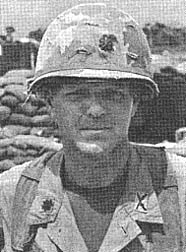 |
Tropic Lightning Tots
The Commanding General Welcomes
The Following Tropic Lightning Tots
To The 25th Infantry Division – As
Reported By The American Red Cross.
Born To:
| July 2 SP4 George C. Hess, HHD 86th Sig Bn, boy July 3 SSG Fred W. Gouldsbrough, D Trp 3rd Sqdn, 4th Cav, girl July 5 SP4 Kenneth N. Mathis, Co A 125th Sig Bn, boy PFC Kerry Fleming, HHD 1st Bn, 8th Arty, girl |
July 6 SSG Edward Matthews Jr., Co C 25th Med Bn, girl SP4 Richard J. Burnett, HHT 3rd Sqdn, 4th Cav, girl July 7 SGT Alvin B. Smith, Co E 2nd Bn, 14th Inf, girl July 8 CW2 Raymond Hults, Co E, 725th Maint, girl |
The TROPIC LIGHTNING NEWS is an authorized publication of the 25th Infantry Division. It is published weekly for all division units in the Republic of Vietnam by the Information Office, 25th Infantry Division, APO San Francisco 96225. Army News Features, Army Photo Features, Armed Forces Press Service and Armed Forces News Bureau material are used. Views and opinions expressed are not necessarily those of the Department of the Army. Printed in Tokyo, Japan, by Pacific Stars and Stripes.
MG Edward Bautz, Jr . . . . . . Commanding General
MAJ Warren J. Field . . . . . . Information Officer
1LT John Caspari . . . . . . . . . Officer-in-Charge
SP4 Bert Herrman . . . . . . . . . Editor
SP4 Scott Watson . . . . . . . . Assistant Editor
SP4 Joseph V. Kocian . . . . . Production Supervisor
BATTALION CORRESPONDENTS
| SGT Mike Keyster SP4 Tom Benn SP4 Frank Salerno PFC Nick Haren SP4 Henry Zukowski PFC Robb Lato SP4 Greg Duncan SP4 Rich Erickson SP4 Ed Toulouse SGT Mike Conroy SP4 Dan Davis |
4/23 7/11 2/22 2/22 2/22 2/27 2/27 2/14 2/12 3/4 Cav 1/27 |
SGT William Zarrett SGT Daniel House SP4 George Graham SP5 Tom Watson SP4 William McGown PFC James Stoup SGT Derr Steadman SP5 Doug Sainsbury SP4 James Duran SGT Jack Strickland |
4/9 4/9 269th 725th Divarty 65th Eng Discom 2/77 3/13 1/27 |
Page 3 TROPIC LIGHTNING NEWS July 27, 1970
The Nose Knows
Canine Sniffs Out Caches
By SGT TIM WHALEN
TAY NINH - When foot soldiers from the 1st Brigade humped through the
unfamiliar jungles and forests of Cambodia, the dogs and handlers from the 46th
Scout Dog Platoon were walking point.
Throughout the Cambodian campaign, captured enemy caches were plentiful and
well-publicized. Usually omitted from the news stories was the fact that many
of these large caches were discovered as a result of the scout dog’s sniffing.
20 Teams
The 46th Scout Dog Platoon has 20 operational teams at full strength. But on
May 6th, when Operation Bold Lancer kicked off, several of the dog-handler teams
were on medical holds. Although some of the dogs were “grounded,” the handlers,
shotguns in hand, went to the field to provide extra security for other scout
dog teams on the operation.
Even though short-pawed at first, the 46th Scout Dogs chalked up an
impressive record. Assisting both mechanized and leg companies the teams
sniffed out a total of 25 tons of enemy rice on more than 350 missions across
the border.
Besides the rice, the scout dogs alerted on numerous caches containing
weapons, communications gear and explosives.
Reminder
In one instance, handler Specialist 4 Thomas Toney, of Tigard, Ore., while
working in heavy jungle, came across some structures about eight to 10 feet
high.
“We got past two of them before we realized what they were part of an enemy
obstacle course for training new troops.” Then he laughed and added, “It was
like a bad dream - I thought I was back in basic!”
725th-RFs Open Day Care Center
By SP5 TOM WATSON
CU CHI - A child day care center built with materials supplied by the 725th
Maintenance Battalion opened here recently. It was built by men from the 132nd
Regional Forces Company located in the village.
The center is in a renovated building that underwent an extensive facelifting
inside and out. Inside rejuvenation included a new tile floor and fresh coat of
paint.
A small swing and hobby horses were set up on the grounds and the battalion’s
service section is building a large swing set out of pipes and chains.
Extensive landscaping makes the building more pleasant to look at.
“The thing that makes me the happiest about our work is the joy it brings to
the kids,” 1st Lieutenant Daniel G. Russell, Fulton, Mich., the battalion civic
action officer, said.
The battalion has other projects also: Early this year the 725th gave funds
and supplies to villagers at Vinh Ninh for construction of a Buddist school
there. In early June a two-room elementary school built with 725th funds and
supplies at Lao Ta, a resettlement hamlet, was dedicated. It is the first
school in that community.
Automated Ambush is Numbah 1
By 1LT ROBERT GOLDEN
TAY NINH - Patience and professionalism paid off recently for the infantrymen
of the 2nd Battalion, 60th Infantry, under operational control to the 25th
Division.
They spent one recent night carefully planting claymore mines in the jungles
of War Zone C, about 18 miles south of the Cambodian border area known as the
“Fish Hook.”
With the mines planted and set to go off, the men left their mechanical
ambush location and returned to the company laager position.
The next morning, when the troopers from Charlie Company went back to check
the ambush site, they found five dead NVA soldiers who had detonated the ambush
sometime during the night.
The Charlie Company grunts also policed-up three AK-47 rifles, three ponchos,
one backpack, and a small amount of rice.
They Get Through
By SP4 FRANK H. SALERNO
THIEN NGON - Armored personnel carriers in the front and rear provide
security and help remove obstacles for the daily convoy of Delta Support
Company, 2nd Battalion (Mech), 22nd Infantry, “Triple Deuce.”
“It’s really cool to watch the carriers mow down trees, bamboo and heavy
brush,” says Specialist 4 Walter Goodwin, from Placerville Calif.
Since the brush is so heavy on both sides of thy road, the convoy exposes
itself to enemy ambush many times each day. Land mines are another constant
hazard.
Combat hazards are complicated by rainy season problems. Mud threatens and
sometimes succeeds in stalling vehicles. Breakdowns are not unusual. If the
breakdown occurs on the road, the vehicle is either repaired on the spot or
towed to the resupply point.
Despite all the hazards of each seemingly endless day, the resupply always
arrives. “The greatest thing is to know that we will always have chow and mail
call.” says Galan Duff of Headquarters Company, Triple Deuce, from Kewanna, Ind.
“Our motto is, `Nothing stops Delta resupply,” says Specialist 4 Delmer
Shoemaker, a Delta Company member from Wichita, Kan. “We try very hard to live
up to it.”
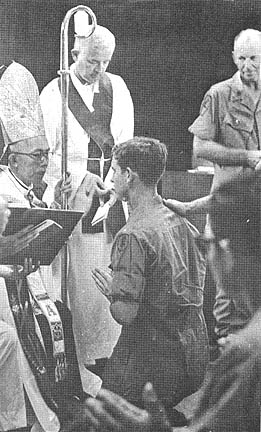 |
CONFIRMATION -- Bishop Van Thiem administers the Sacrament of Confirmation to a Tropic Lightning troop. (Photo by SP4 Joseph V. Kocian) |
Soldiers Confirmed, Join Christ’s Army
By SP4 JOSEPH V. KOCIAN
CU CHI - Twenty-four Tropic Lightning soldiers recently became “Soldiers in
Christ’s Army,” when they received the Roman Catholic sacrament of Confirmation.
Bishop Van Thiem of Pu Cwong Administered Confirmation. Bishop Van Thiem is
head of the diocese, of which Cu Chi is a part.
Assisting the bishop were Chaplain (Lieutenant Colonel) Roy Peters Division
Chaplain of the 25th Division and head chaplains from the 3rd Brigade, 9th
Infantry Division and the 86th Signal Battalion. Chaplain (Colonel) William
Fitzgerald of MACV, head Roman Catholic chaplain in Vietnam said the Mass.
Confirmation means “making strong” or “strengthening.”
According to Roman Catholic doctrine, Confirmation “strengthens” or
“completes” the work begun by Baptism.
 |
| SECURITY -- Members of 2nd Battalion (Mech), 22nd Infantry Scout Platoon stand ready to avert any attempt to ambush resupply convoys traveling Highway 22 between Tay Ninh and Thien Ngon. Later the convoy must cross through miles of heavy brush. (Photo by SP4 Henry G. Zukowski) |
Page 4-5 TROPIC LIGHTNING NEWS July 27, 1970
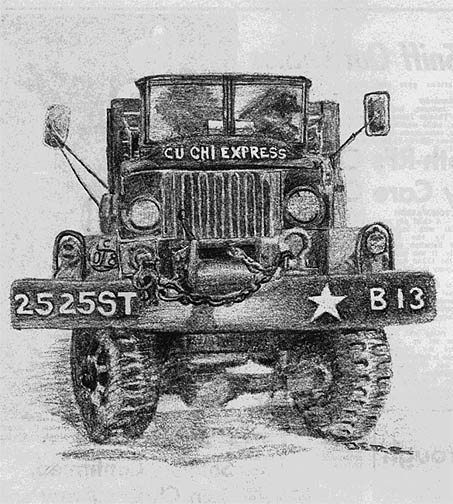 |
Cu Chi Express
|
CU CHI -- “We haul anything from dirty socks to armored personnel
carriers,” Specialist 4 Connie Thomas, Jr., Beaumont, Tex., a truck driver for
the 25th Supply and Transportation, said. Thomas drives a five-ton truck in the
daily resupply convoy that churns up miles of dust on the roads between Cu Chi
and Dau Tieng.
Every morning truckers from Bravo Company -- the “Cu Chi Express” -- leave
here loaded with supplies for units at Dau Tieng. Daily cargo usually includes
refrigerated and dehydrated foods, C-rations, fuel, building materials, laundry,
paper plates and toilet tissue.
Occasionally convoys are organized for transportation of troops when entire
units are transferred from one base to another.
“There’s no telling what we’ll transport from day-to-day,” Sergeant First
Class Edwin D. Hatch, a medium (five-ton) truck driver from Phoenix, Ariz.,
said. “One day we may have only six commitments, the next day we may send every
truck.”
The Cu Chi Express has more than 100 vehicles. They include more than 30
heavy duty, five-ton tractor trailers and twice as many two-and-one half ton
trucks. Bravo Company is on the road all day every day.
They reach base camps and fire support bases throughout the division area of
operations.
The run from Cu Chi to Dau Tieng is typical. The convoy usually reaches Dau
Tieng by mid-morning. Soon after supplies are unloaded there, the convoy begins
the two hour long trip back to Cu Chi. The roads are rough and slippery during
rain storms.
“It can be a really bone jarring experience,” one driver said.
Specialist 4 Billy Davis, Spearsville, La., has been driving the “Express”
for eight months. “Sometimes it’s awfully tiring. The bouncing can get pretty
bad, but I really enjoy the scenery along the road,” he said.
The return trip to Cu Chi is usually completed by mid afternoon. Vehicle
maintenance and other preparations immediately get under way so the “Express” is
ready to move out for Dau Tieng the first thing in the morning.
 |
GREASE, OIL AND ICH -- Preventive maintenance is as important for getting the Cu Chi Express through as drivers and gasoline. |
| LOADING and unloading is the heavy work that goes along with every convoy. |
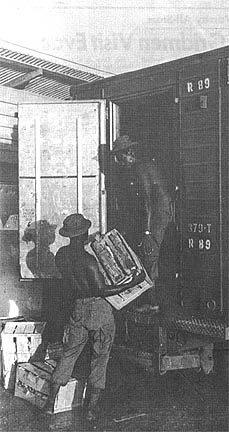 |
 |
PASSING THROUGH -- As the Cu Chi Express goes through Vietnamese villages, children wave and adults go about their business. |
 |
| LONG ROAD -- The Cu Chi Express winds its way up the long dusty road. (Photo by SP4 Jeff Hinman) |
Page 6 TROPIC LIGHTNING NEWS July 27, 1970
Varsity All-Stars
Gridmen Visit Evac
CU CHI -- Four football All-Americans toured the Tropic Lightning Division
recently, as part of a National Collegiate Athletic Association Tour.
While in Cu Chi, Scott Henderson, Larry Dinardo, Mel Gray and Scott Hunter
visited the 12th Evacuation Hospital, treating the patients to a combination of
pigskin previews and souvenir varsity T-shirts.
Chuck Neinas, NCA Assistant Executive Director accompanied the athletes as
they showed films of last years great games and answered questions for the men.
“Everyone seems to want to know what last year’s toughest game was,” said
Larry Dinardo, captain of this years Notre Dame team, “and believe me, they are
all tough.”
Mel Gray is a two season threat for Missouri. During the fall he was the
fastest end in the Big Eight and caught 10 touchdown passes. Come spring, Mel
sheds the pads and uses his imposing speed at track meets.
Scott Henderson will captain the Texas Longhorns in their attempt to repeat
last year’s National Championship. He plays in the linebacker slot for UT.
Scott Hunter may be destined to become one of the greatest passers in Alabama
history. He connected for 22 of 29 attempts in last falls classic 33-32 win
over Mississippi.
The All-Americans wrapped up their visit with a trip to Dau Tieng.
| STREAMLINED -- The Warrior go-cart is ready for action. (Photo by SP4 Rich Erickson) |
 |
Waikiki Pool Open
CU CHI -- Waikiki Standdown area once again has a swimming pool. Division
Chief of Staff, Colonel T. J. Hanifen had the honors in a reopening ceremony
held recently.
Men of the Charlie Company, 65th Engineer Battalion, who had worked on
around-the-clock shifts in order to finish the pool as quickly as possible, were
invited to take the first dip.
Division Special Services Officer, Captain Thomas H. Dexter of Cleveland,
Ohio, explains the work that was necessary to restore the pool:
“When the old liner of the pool tore several months ago, the pool was
emptied. The pressure from the water table on the sides of the pool caused the
walls to cave in. It was necessary for the engineers to drive 15 foot steel
piles along the walls in order to secure the sides. Then a heavy rubber line
was fastened inside. This liner is stronger than the previous one and should
stand up under anything.”
Go-Cart Races ??
By SP4 ED TOULOUSE
DAU TIENG - There’s going to be a go cart race here - maybe.
The Warriors who run the 2nd Battalion, 12th Infantry, motor pool have built
their own GI-style go cart and are looking for competitors. The plans for the mini car originated in the grease-scented, nut and bolt
atmosphere of the Tropic Lightning repair shop at Dau Tieng.
What the men felt they needed was a mechanical means of self expression - a
chance to “do their thing.”
“We’ve wanted to build something of our own for quite a while,” Specialist 5
Ernest St. John, Manchester, N.H., said. “But it wasn’t until recently that we
got the materials to work with.”
The result is a low slung, tubular framed four wheeler, powered by an ancient
and rather reluctant water pump engine.
Performance on the trial run could not be labeled “instant response” but
things were going smoothly until the machine’s makeshift drive belt fell off.
However, in pit stop time, the belt was back on and the Warriors were off
again.
‘Neither Rain, Nor Sleet, Nor Dark . . .’
CU CHI - Who says mail doesn’t go through in the Army?
There’s a “Regular” from the 2nd Battalion (Mech), 22nd Infantry who knows
that isn’t so. He got his mail -- a year late maybe -- but he got it.
Originally the letter was sent to Private Gary Warner at his combat training
unit at Ft. Polk, La., in June 1969. Unfortunately he had already left there.
From Ft. Polk it was sent to the Republic of Panama where he was attending a
jungle training course. The course lasted only two weeks and the letter missed him
again.
From Panama it went to Charleston Air Force Base where Warner was sent after
leaving Panama. Still no luck. Then to Oakland, Calif., where he had reported
for transportation to Vietnam.
From Oakland it went to RVN where, after some 20,000 miles and 12 months and
10 days in transit, it finally reached Specialist 4 Gary Warner.
| Ilikai East by Night WED Floor Show THU Learn a new game; Whoopee (8 p.m.) FRI Cookout on patio (8 p.m.) SAT Tournaments: pool and Ping Pong (2 p.m.) Movies and popcorn (7:30 p.m.) SUN Coffee Call (10 a.m.) Tournaments (2 p.m.) Bingo (8 p.m.) MON Roll it and Keep it (8 p.m.) TUE Contract Bridge Tourney (8 p.m.) |
Ask Sgt. Certain
DEAR SGT CERTAIN: While driving along the other day in my M151Al quarter-ton
truck, I heard a suspicious knocking from under the hood. When I stopped and
opened it, oil sprayed all over the engine and the fan belt looked like someone
had made it out of five boot strings. When I turned it in to the motor pool,
they blamed me because I hadn’t been waxing it enough and locking it when I
stopped. What should I do?
PFC R. NADER
DEAR PFC: A jeep is like a pet dog; good grooming is part of good health. You
wouldn’t let your toy poodle run around without tags. How could you think of
not locking your jeep? In a special supplement to the M151A1 truck TM,
published by the ASPCA, there are instructions on how to teach your jeep tricks
like “rolling over” and “stand up and beg.” Remember, feed your dog plenty of
Mogas and most important, don’t forget PM (Pet Minding?).
DEAR SGT CERTAIN: Is there any truth to the rumor that the AFL-CIO is thinking
of adopting the 25th Division Motto?
CPL Afenz
DEAR CPL: No.
DEAR SGT CERTAIN: I’ve sent my clothes to commercial and quartermaster
laundries, and even done it myself, but every week I have another sock missing.
Everyone else I know has the same problem. What can I do?
Sock Ittomee
DEAR SOCK: It used to happen to me too, but no more. Now I take a safety pin
and pin all my dirty socks together. The only problem is that every few weeks I
lose the whole thing.
Page 7 TROPIC LIGHTNING NEWS July 27, 1970
Learning & Relearning
 |
HARD PULL -- Miss Tran Thi-Tinh extracts a tooth from a Vietnamese worker. The 19 year old has been trained as a dental hygienist and is presently working at the Golden Dragon Aid Station. |
Local Girls Aid Medics
By SP4 RICH ERICKSON
DAU TIENG - The Womens’ Liberation Movement could be proud of two ambitious
Vietnamese girls working at the 2nd battalion, 14th Infantry, “Golden Dragons”
aid station here.
Tran Thi-Tinh, 19, is a dental hygienist at the 2d Battalion, 14th Infantry
dental clinic. She has been trained over the past two years to clean teeth,
take X-rays, prepare instruments and reports, and extract teeth. An asset is
her ability to speak English, which enables the dentist to inform the Vietnamese
patients of their dental problems and proper care of the teeth.
Mai, her GI name, takes much of the Work load off the dental staff and is a
reassuring sight to the Vietnamese on their first visit to the dentist.
Dao Thi Gai, 18, has been trained for three years by Army doctors and now
performs all the duties of a registered nurse. “Kim,” as she is called by the
staff, treats mostly the Vietnam workers at Dau Tieng. However, she
occasionally assists the doctors in the treatment of injured GIs from the field.
Kim hopes to attend Saigon University and become a doctor. “But,” she
explained, “it will cost a lot of money, so right now I’m trying to save as much
as possible. Maybe I will have enough to start in two years.”
| STITCHES -- Miss Dao Thi Gai, 18, demonstrates her skill in suturing a small cut suffered by a Vietnamese worker in Dau Tieng. |
 |
|
Grunts Review Skills in the Field By SGT MIKE KEYSTER and SP4 RICH ERICKSON CU CHI - “Ready on the Right ... Ready on the left ... Ready on the firing line ... The firing line is no longer clear...” The familiar lines are heard once again at 25th Division outposts, where combat-hardened troops are given a chance to refamiliarize themselves with the weapons available to them. At Dau Tieng, the division’s 2nd Battalion, 14th Infantry, “Golden Dragons,” has instituted a review training program so everyone - including clerks, motor pool and other rear echelon troops - has a chance to zero his M-16, fire the 90mm recoilless rifle, the M-60 and .50 caliber machine guns, the M-79 grenade launcher, and even throw a live hand grenade. Unlike stateside training, field training is not for the rank amateurs. There are no AI cadre to call when a ‘16’ jams and no nervous E-6 in the grenade pits to help a guy pull the pin “by the numbers.” At Katum, several miles south of the Cambodian border in War Zone C, the 4th Battalion (Mech), 23rd Infantry also has a review area. The review,” according to First Lieutenant Hewitt Harned of Frankfort, Ky., “is based on some lessons learned in Cambodia.” “Part of the program, such as zeroing individual weapons,” Harped continued, “should always be practiced, but was not previously possible in the field.” Besides review of their weapons, the Tomahawks at Katum study rules of engagement, ambush and counter-ambush techniques and patrolling. Also emphasized are communications procedures, small unit tactics, formations in movement and night vision devices. AIT training once again becomes a reality for the 2/14th,” Golden Dragons,” and the 4/23rd “Tomahawks,” when they hear those immortal words, “Lock and load one 18 round magazine, and watch your lanes.” |
Page 8 TROPIC LIGHTNING NEWS July 27, 1970
UFs and PFs
Academy Trains Locals
By SP4 RICH DOMBROWICKI
CU CHI - Recently, at Bau Dieu hamlet, three miles north of here, combined
Popular and Regional Forces operations eliminated a Viet Cong terrorist unit
that had been plaguing the area.
The success of the operation was attributed to the skill of the combined
element. Another factor, however, was the new training program being conducted
at the 25th Infantry Division’s “Tropic Lightning Academy.”
Experienced Troops
“The program takes experienced members of local Regional and Popular Forces,
instructs them in various combat methods and operations, and sends them back to
their units as fledgling instructors,” said Captain Donald Parnell, TLA deputy
commandant.
The RF-PF school consists of four days of orientation, discussions and
demonstrations, plus some practical work by the students. Class size averages
35 per week. Topics include weapons, tactics and strategy, airmobile
operations, enemy characteristics, interrogation procedures and others.
Useful
“The students are attentive and interested in the instruction,” Parnell, of
Houston, continued. “They know that what they learn here can be used
effectively against the enemy.”
ARVN Instructors
“We have a fine group of ARVN instructors,” said TLA operations officer
Captain Paul A. Manos, Amsterdam, N.Y. “They are top-flight combat veterans and
when they talk the men listen!”
Chief instructor is Staff Sergeant Nguyen Quang Loc, who speaks fluent
English and is responsible for seeing that the training proceeds satisfactorily.
VC Methods
“The men are not new to fighting,” Loc pointed out. “But they need this
training to learn how the VC operates and how to beat him.”
Sergeant Le Van Song, a former sapper, teaches the mines and booby Laps
course. “He amazes the men with his knowledge of explosives and VC combat
tactics,” Loc added.
Written Outlines
After each week’s classes, the men are given outlines of all lessons written
in Vietnamese. They relay the information to their units and become, in effect,
instructors themselves.
“They become part of the program too,” Parnell said. “It gives them
confidence as leaders and a chance to further Vietnamization in their own
villages and hamlets.
The success of the school seems assured. Just ask the inhabitants of Bau Dieu.
| SCHOOL DAYS -- Experienced members of local Regional and Popular Forces get instruction on various combat methods. Returning to their units, they will act as instructors. (Photo by SP4 Joe Loper) |
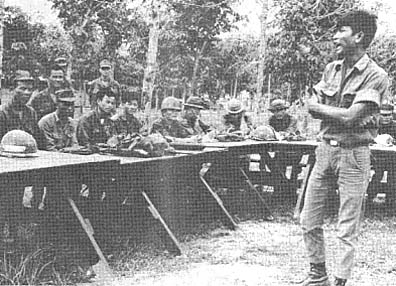 |
Artillery ‘Does’ Getting MEDCAP Satisfaction
By SP4 JAMES L. DURAN
GIA BINH - “I like coming out here and what’s more, I’m the closest thing to
a doctor most of these people will ever see,” said Specialist 4 Faral Jouard,
Queens, N.Y., during a recent Medical Civic Action Project (MEDCAP) here.
Medic Jouard and his colleagues with the 3rd Battalion, 13th Artillery, “the
Clan” and Headquarters Battery, Division Artillery, (DIVARTY) are getting a lot
of satisfaction out of the daily MEDCAPS they are conducting throughout Hau
Nghia province.
Treat and Diagnose
The mission of the MEDCAPS is to handle whatever cases can be treated in the
field with emphasis on skin disease, to diagnose serious illness and direct
persons to medical facilities where they can be treated.
“We treat a lot of cuts and scrapes that are infected because sanitation is
poor,” one medic stated. “Also we discover and treat a lot of upper respiratory
disease and tuberculosis among the old people.”
Use Interpreters
The medics reach reluctant patients through interpreters who explain exactly
what treatment is proposed for them.
“It doesn’t always work,” said 1st Lieutenant Charles Beeghly, Pittsburgh,
the DIVARTY civic action officer. “A very small girl with an ear infection and
a large boil on her head recently came to us with her father. Through an
interpreter we explained that we could lance the boil to drain and clean it.
Also that there would be some pain involved and not to be alarmed if the child
cried.”
“Her father decided not to have her treated. The case could be fatal, but
all I can do is advise her father to take her to the regular sick call at Cu
Chi,” Beeghly said.
Most Patients Willing
But, most of the persons who show up for treatment are eager to have the
medics help them. Many of them return with friends and relatives.
At the same time the medics are treating patients, they keep an eye on
preventive medicine. Recently Clan medics noticed that many of the children in
a nearby village had smallpox symptoms.
“We began a large scale vaccination program,” one medic said. “It was really
satisfying. No smallpox cases have turned up.”
| MEDCAP -- Two members of the 3rd Battalion, 13th Artillery, finish bandaging a young girl’s leg during a recent Medical Civic Action Project. (MEDCAP). (Photo by SP4 James L. Duran) |
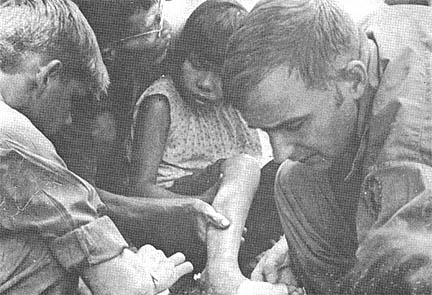 |
2/22 Scouts
Spying on Charlie
By SP4 HENRY G. ZUKOWSKI
CU CHI - “Spying” on the enemy is the specialty of 2nd Battalion (Mech), 22nd
Infantry’s Scout Platoon. Aboard armored personnel carriers the platoon rips
through thick jungle canopy and underbrush searching enemy tunnels, bunkers,
fighting positions and trails.
“We can determine how long ago the enemy was in the area just by what he left
behind,” said 1st Lieutenant Frank Ratka, Foley, Minn., the Scout Platoon
leader.
By capturing documents and supplies, examining footprints in an area and
searching enemy hideouts, the Triple Deuce Scouts can determine enemy buildups,
new staging areas and troop movement.
Once we found ox cart trails and enemy footprints coming from all directions
leading into a central area,” Sergeant Douglas Jenkins, Highland, Wis., said.
“Through our information the buildup was destroyed before it ever started.”
“Gathering intelligence from the enemy can determine a lot about the enemy
troop size, direction of movement and planned attacks on our positions,” Jenkins
said.
Ben Sells Records
CU CHI - The Tropic Lightning Association salesman, Benny, has begun the
sale of a thousand copies of the new division record featuring the 25th Infantry
Division Band.
The record includes the band and chorus playing The Army Goes Rolling Along,
the Tropic Lightning Division song - The Famous 25th, as well as popular songs
and old favorites.
Records can be purchased for two dollars by contacting the Division
Information Office.
Also available are the Vietnam: 1969 yearbooks, machete letter openers, and
waterproof wallets with the Division’s “Electric Strawberry” insignia on them.
Coming soon will be cigarette lighters and drinking mugs.
| RECONNAISSANCE -- Triple Deuce armored personnel carriers move along heavily used enemy roads and trails gathering valuable intelligence, south of the Cambodian Border near Thien Ngon. (Photo by SP4 Henry G. Zukowski) . |
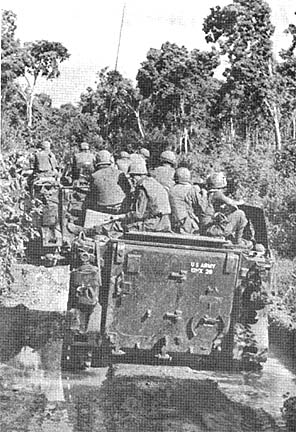 |
Thanks to:
Roger Welt, 4th Bn., 23rd Inf., and a Tropic Lightning News correspondent,
for sharing this issue,
Kirk Ramsey, 2nd Bn., 14th Inf. for creating this page.
This page last modified 06-18-2006
©2006 25th Infantry Division Association. All rights reserved